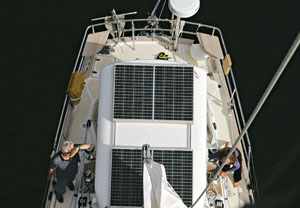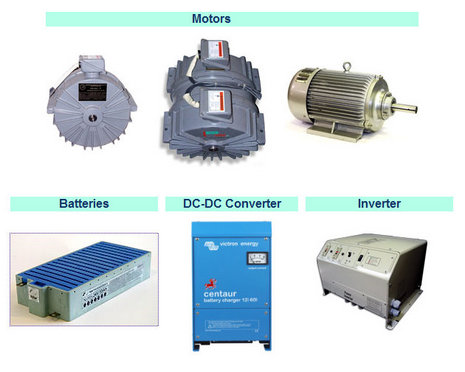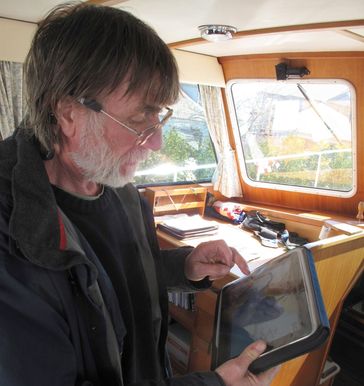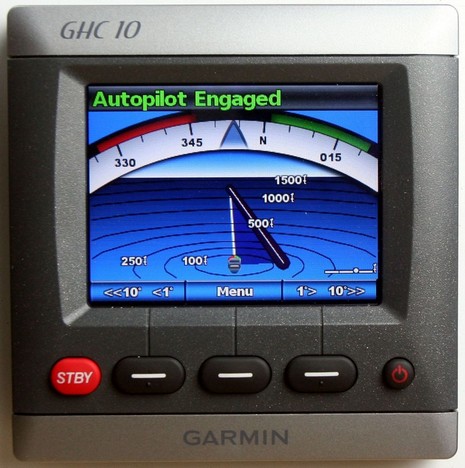HYMAR, can Nigel find the electric drive grail?
I remember getting excited about Solomon Systems’ regenerating electric sail boat motors at the 2004 Annapolis show, but I never hear about the technology today. Then in late 2006 I got stoked about the Ossa Powerlite diesel electric system, and even dreamed of having one in a Maine Cat P45 (which went on to become the great P47). But Maine Cat dropped the idea after testing it on the prototype, and the Ossa web site today shows about the same few customers it showed back then. Designing a truly practical electric drive system for cruising-size boats, great as it sounds, is clearly not easy. However, Nigel Calder did his homework on these systems all along — and often was properly skeptical when others, like me, were infatuated — and now he’s put together an A list of companies and earned a $3,000,000 EU grant to develop hybrid marine propulsion. How cool is that?
The project is called HYMAR, and it’s not very well documented online yet. The best overall description I’ve found is at E motion Hybrids, the firm that integrates the components seen in the top photo. Nigel is also blogging occasionally about the testing he’s doing in Sweden on his new Malo 46 Nada IV, and he did this recent Q&A in the Pacific Northwest. And he’ll be delivering two seminars at IBEX in Miami next month. The guy is putting in a lot of miles, and hence is really hard to catch back here in Maine, where he lives now, sort of. Though he didn’t quite make it aboard Gizmo last June, I was happy to learn to that HYMAR is hopeful, if not insistent, that NMEA 2000 will be the bus that integrates all the parts in the ultimate hybrid system. I’m really looking forward to what HYMAR comes up with, and in the meantime was pleased to find Nigel’s latest thoughts on solar panels (which Gizmo needs badly).















How much horsepower? How much weight? Hom much cost?
Personally I always thought the “Wheel” was the wrong approach on auxiliary power for a sailboat…Of course it appeals to the gee whiz its cool and with a price to match but everyone I ever talked to with a Solomon Wheel was not exactly a happy camper.
On the other hand I do happen to be a happy camper and have now had electric propulsion going on seven years(all of it full time cruising) it works and it does not have to cost a fortune in the process. Whether it be cheap off the shelf components for golf carts or sensible systems like the ones being built by Electric Yacht it is already a doable system for auxiliary power for sailboats where less is actually more (sorry power boaters you’re still in the dark ages).
Its going to happen sooner or later. As with any new technology, it should evolve for the better over time.
The challenge will be synchronizing and balancing all components (motor, generator, alternative inputs like solar, wind, etc). In terms of “kw-per-unit-of-fuel” a straight diesel still has best efficiency, except in the most simplest of applications.
The burden of this evolution will be on generator and system control technology.
A diesel generator charging large batteries powering an electric motor is still very inefficient, largely due to inefficient generator technology.
I built a 43′ sailboat in 2004 that is powered by an electric motor and battery bank that I purchased from Solomon Technologies. (Now sold by Electric Marine Propulsion.) When I’m sailing over 4 kts the regeneration provides all the power I need to run my boat systems including a refrigerator, autopilot, computer, radar, etc. The loss of speed from the prop resistance is proportional to the boat speed. At 6 kts I lose about .2 kts, at 7 kts I lose about .5 kts, and at 9 kts I lose about .7 kts. To eliminate those losses when I don’t need to recharge my batteries I can give some throttle to the electric motor to reduce the charge level to a fraction of an amp. Quiet is a huge advantage. When I’m motor sailing over 6 kts with the genset on, the wave noise blankets the sound of the motor/genset. The real advantage however is improved safety. Because the electric motor is always on (for regeneration) it is instantly ready to power the boat without any warm up time. So if an unexpected situation arises I have full power as quickly as I can grab the throttle. The other advantage is that I can run the motor for about an hour from my battery bank, so if the diesel genset shuts down I still have enough power to get me out of trouble. In calm conditions I motor at about 6 kts using half a gallon of diesel per hour. If you wish to contact me or learn more about Prestissimo you can visit my website, Prestissimo.org. I’ll be anchored out at the Annapolis Boat Show. Prestissimo has a blue hull and an unstayed mast. Come by and say hello if you like.
As Robert points out a sailboat can survive almost solely on solar power (hey some sailors have no engine at all, like the Pardeys and the sailors from centuries ago). But you need a genset to make it really work.
Solar and a reasonably sized battery bank will get you in and out of the slip without starting an engine. But any more than an hour or so each day requires a genset.
But a genset is probably 30-50 percent less efficient than a direct drive diesel. Small gensets are lucky to convert 70% of their kinetic energy to KWs, but direct drive engines have only about 5% transmission losses. Add to that losses in the electronics. So if you use your genset at all to power you, then you are not being very “green”.
And power boaters don’t stand a chance. For a typical 20-30,000 lb trawler it will take a 50 kw genset to move the boat at hull speed. And don’t even think about operating from only the sun. There isn’t enough roof area to hold the solar panels it would take to make 50 kw unless the panel efficiency gets to 100%.
Martha!, you’ve got to plug in the sails before you run that hair drier; nanoparticle ink can’t read your mind you know.
For a multihull owner the additional weight of the batteries and generator, is too much for the design of the vessel.
There is no fault tolerance, if you have one heavy DC generator.
Personally I like E-cycles solution, as they have a high current and lightweight alternator/motor of clever design. Which has weight and size savings over coventional designs.
For my multihull two custom Kubuta D902 DC generators (about 12KW each) total weight 100Kg each (3 cylinder engine+alternator), and two twin counter-rotating propellor 10KW outboards 35Kg each with a regenerative convertor seems to be the ideal leightweight solution. Total wieght 270kg
Currently have two large Yamaha outboards, and a Mastervolt generator. Total weight 230Kg
Makers of the above http://www.ecyclemarine.com The dual prop outboard is still being developed. http://www.yachtforums.com/forums/attachments/general-yachting-discussion/1502-electric-outboard-motor-ecycle-outboard-9.9-hp.jpg
Though am waiting for the product development to be completed first.
Not sure if like the idea of thin lead AGM cells, for electric drive (life expectany), Mastervolt has just released some new high energy density AGMS AGM slimline which are interesting.
Not sure about Lithium Ion or Optima Blue batteries, as Lithium Ion die in 2.4-4 years depending on how hot/cold they are kept and Optima’s blow their valves (become useless) if the charging current is too high.
I am right in the process of replacing my gas outboard on my 32ft catamaran with a 2kw 24volt Torqeedo outboard.
4 80 watt solar panels are mounted on the pilothouse roof to recharge the 24volt battery.
Solar panel performance is quite impressive considering they are mounted flat and it is Sept.
I have been getting up to 250 watts out of a possible 320 from the array.
I think this might be a cost effective alternative to the high priced inverter /ac motor systems.
Sea trials will start in a month or two.will let you know.
Torqeedo offers a 2Kw lithium magnesium battery which is way cool but the price is way scary.
Also ..all lithium batteries degrade on the shelf typically 4% a year even under ideal cool storage situations.
I will probably go with gel or AGM for now.
best bang for the buck.
And lets not go to home made lithion battery banks made from buying a whole bunch of cordless drill batteries and cutting them open!
Very glad to hear that some electric drive systems are working well. Readers, do NOT miss the web sites RLW, robert, and Joseph Huberman have created…all good. Just click on their names above.
Is there a good external battery option (including case) for these Torqeedo’s that would make sense in a dinghi where it gets exposed to water ?
Dan, I haven’t written about it yet, but I’ve been trying a Torqeedo Travel 8001 as a dinghy (hard shell and inflatable) motor for several weeks now. It has a small (but expensive) lithium mangnesium battery that just flips on and off for charging at home or on the big boat. It’s amazingly powerful, at least for a while, and when used more efficiently will push my 11′ tender for at least an hour at better than rowing speed. I’m trying to quantify the battery performance better.
http://www.torqeedo.com/us/hn/products/travel.html
I think I have room to evaluate one more product this year, although I was looking for something N2K to test and add to the Adventures In N2K Part IV piece, I would be happy to follow-up on that torqeedo for you 🙂
My interest in the external battery was to get the 4hp or 6 hp models, like the 2.0S. A 4 or 6hp gas engine is way to heavy to transfer back and forth from my dinghi to my tiny sailboat swim platform.
I found that a 2.5hp gas engine, although I am comfortable with it’s weight, is to small for my needs. It’s possible the 8001 would meet my needs (it shows power = 2 hp, thrust = 4hp) if the 4hp number is what is comparitable to gas engines. I am doubtful, but if the 8001 can satisfy me with a 10ft inflatable dinghi, I would be impressed.
Look forward to reading your report, although what I really look forward to is more coverage on the Radar’s.
I have budgeted for taking my mast down during the winter and replacing much of the hardware (the lights have become unreliable), replacing some cables (my radar cables are looking a little warn from swinging on the self leveling mount), and am (almost) sold on a radar upgrade.
I’m converting a 57′ S&S sloop to hybrid electric right now in Rockland, Maine. My reasons for doing this could go on for pages but but essentially it was to re-trim the boat more forward and to get rid of some systems that were noisy and dying. I ordered a system from Electric Marine Propulsion August ’08 and it still hadn’t been delivered as of June. I finally cancelled the order and am still waiting for my substantial deposit to be returned.
Having already dismantled the old systems, I started integrating the system myself. We’ve installed a 34kW Westerbeke generator which has been converted to 326-352 vdc output, 28 Odyssey P2250 thin-plate AGM batteries, and a UQM 50kW motor. We’re building the control PLC and the control and safety circuitry and will be installing it within about a month.
We’ve been able to preserve most of the 120 vac and 12 vdc wiring and panels, but we’ve put the big loads directly of the 326v bank. These include the propulsion motor, 10hp electric motor to run all the hydraulics, radiant space heating, and an inverter from Dimensions (which is the same as the EMM picture in your original post).
As part of the refit, we’ve replaced the two holding tanks with Lectrasans, replaced the Glacier Bay air conditioning with two 16K btu Dometic units, and replaced the Glacier Bay refrig and freezer with SeaFrost. Also, the console has all become simpler and I’m laying it out again.
The project was pretty depressing for a long while, but now as it’s coming together it’s just amazing how simple it all looks, and how maintainable it’s all become. I’ve become psyched and I’m dying to launch in the spring.
If anyone would like an education on
wet cell, GEL, normal AGM and TPPL AGM please give me a call
561-638-2309
I am the Marine Sales Mgr for Odyssey..
For those interested in information on Lithium Iron Phosphate (LiFePO4) batteries, feel free to contact me. I’m a rep for both Genasun and RaceCell (two different price points)systems.
Bruce: 207-443-3743
We have started testing the Retractable Green Motion system and will keep you updated on the results.
The general layout is as follows.
Installed on a FastCat 445
2 x 9.6 KW retractable electric motors/generators
1800 Wp solar panels
200 watt wind generator
35 KW lithium ion batteries (LiFePO4)
22 KW backup diesel generator
Water cooled motor controllers ( hot water is used to heat the water heater )
The complete boat is electric.( cooking , hot water and Propulsion )view http://www.youtube.com/watch?v=nl1a_ACQmvs for the motor retraction system